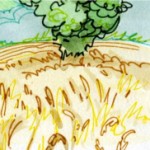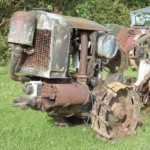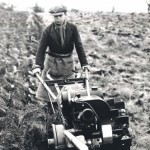Home › Forums › The Machinery Forums › Pedestrian operated machines › Trusty: Help re Coulter Problems
- This topic has 6 replies, 3 voices, and was last updated 8 years, 11 months ago by
 vhgmcbuddy.
vhgmcbuddy.
-
AuthorPosts
-
June 3, 2015 at 7:36 am #13279
 vhgmcbuddyMember
vhgmcbuddyMemberI have had problems with the height/depth of the coulter wheel in that I do not seem able to get it down enough. The wheel is at the bottom of a vertical bar bolted to a bracket on the plough. On close inspection it looks as though this bar has removable spacers on it. If that is so, on mime the spacers have never been removed and are now rusted together. More importantly, I wonder if one or mors spacers are missing. It would help me considerably if any sucessful Trusty user could tell me the vertical distance of the wheel below the beam or the length of the vertical bar.
June 3, 2015 at 1:25 pm #13280 charlieKeymaster
charlieKeymasterThe important measurement is the height above and distance from the plough point, one of our ploughmen will know the answer.
June 4, 2015 at 6:43 am #13283 vhgmcbuddyMember
vhgmcbuddyMemberThanks Charlie
June 4, 2015 at 7:09 am #13284 trusty220Keymaster
trusty220KeymasterYou are quite right- there is a series of spacers on the bar which normally rust together. The easiest way to free them off is to dismantle as much as you can (take the disc off and it’s arm at least) then put the whole assembly into the middle of a very hot bonfire; I use a 45 gallon drum filled with pallet wood. At the end of the fire you should be able to pull it all apart.
The centre spindle that it all assembles onto is round bar with two flats machined on it- this leaves some large gaps down which soil packs hard, jamming the spacers on and encouraging rust to form. That’s why you have to get it all red hot to dry it out and convert the rust back into powder; it should come apart then, providing you’ve got it hot enough!
When ploughing I tend to find that the critical distance is between the tip of the ploughshare and the bottom of the disc. Normally three fingers is the gap, but so long as the disc bearing isn’t bulldozing the topsoil on the left hand side and there is some sort of gap between the disc and the share for stones to pass through then anything is correct.
Your width should be set to 9″ or 10″ and depth of work about 6″ or 7″; so long as you have the plough set around there you should then be able to set the disc about 1″ to the left of the share.
Obviously it all depends on soil type, compaction, etc., which is why different people keep winning the ploughing matches. It is more of an art than a science!June 4, 2015 at 9:28 am #13285 vhgmcbuddyMember
vhgmcbuddyMemberThanks Geoff,As ever your reply is much appreciated. Three fingers, about 1.5h inches. I have been setting much too low. Not sure I understand width setting. I am aware of the lateral screw that sets the whole plough unit at an angle – tip more left, back of mould more right – or vice versa. It more angle = wider? Forgive me if this is a silly question.
Chris
June 4, 2015 at 12:27 pm #13287 trusty220Keymaster
trusty220KeymasterThe width setting is the one on the top of the headstock. To measure how wide you are ploughing you put the plough in the ground and pull it forward to achieve it’s normal running depth. If you stand at the back of the machine and look at the landslide (or the main beam) it should be vertical- if not, adjust the angle on the two bolts that attach the plough to the drawbar. The holes are slotted so should slide easily around the tapered mandrel in the middle.
Once you know that the plough is vertical, pull it forward until it seems to settle down again then you can take your measurements.
The width is measured from the face of the disc to the vertical face of the previous furrow (the one that the right hand wheel should be in). I usually set mine to between 9″ and 10″ by turning the transverse screw on the top of the headstock. I also try to set the disc about 1/2″ to the left of the plough point by adjusting on the disc mounting slide.
The only other adjustment is the depth which you adjust on the long screw that sticks out of the back; it needs to be about 6″ to 7″ measured from the top of the vertical cut to the bottom of the furrow.
You can then adjust the disc height to suit the conditions, but I usually run with all the spacers under the slide (at very most I take one spacer out and put it above the slide); at this it usually puts the disc bearing just clear of the soil. On no account let the bearing housing for the disc bulldoze the soil because it will pick up sand and wear it out.
I hope that helps!June 4, 2015 at 4:29 pm #13288 vhgmcbuddyMember
vhgmcbuddyMemberGreat. Many thanks
-
AuthorPosts
- You must be logged in to reply to this topic.
